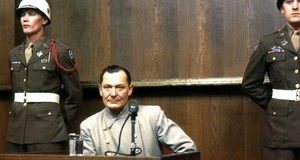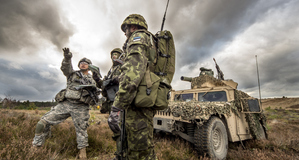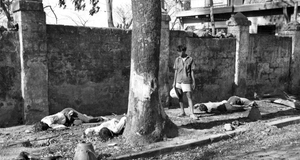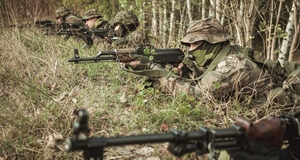|
From Cornell International Affairs Review VOL. 7 NO. 2 Realism Versus Idealism at Nuremburg: The Creation of the Court
In addition to providing a realist perspective on the United States’ choice not to support the UN War Crimes Commission, Stimson’s plans also originated out of a complex bureaucratic process. Although Stimson formulated the plan, the inner workings of the War Department and the Joint Chiefs of Staff lead to its implementation. Throughout the conception of Stimson’s plan, he emphasized the military procedures already in place for criminal prosecutions. Stimson, Hull, and Forrestal wrote to President Roosevelt: “Atrocities committed against our nationals by identifiable Axis individuals will remain subject to trial by the United States military and naval commissions.”25 Stimson’s plan did not seek to replace existing military procedures, but instead sought to augment existing bureaucratic systems.
In part, Stimson’s plan resulted from the precedents of past failures. After World War I, the Allies initiated the Leipzig Trials, where a German court tried German military personnel at the behest of the international community. The trials were faulted for Germany’s inability to locate key perpetrators, the number of acquittals and inconsequential sentences, and the rapid speed with which each trial was performed. The Belgian and French cases at Leipzig only resulted in one conviction and five acquittals, provoking international outrage.26
Considering past precedent, Stimson’s plan required an international court for the war criminals whose crimes involved multiple states.27 However, unlike the Leipzig trials, Stimson’s plan did not involve a German court. Instead, the Nuremberg Trials’ Chief Justice was Geoffrey Lawrence from Great Britain. The United States, France, Great Britain, and the Soviet Union each sent a judge.28 By creating a multinational tribunal, the Allies ensured that the court would not be biased in favor of Germany, resolving previous issues with holding charged criminals culpable.
The Nuremberg Trials illustrate that idealist policies with realist aspects can be practically implemented with new and existing bureaucratic systems.
Stimson’s plan for the Nuremberg Trials therefore avoided past mistakes and implemented already existing military standard operating procedures. In addition, Stimson also implemented the preliminary aspects of his plan prior to President Roosevelt officially accepting it. On October 1, 1944, the Joint Chiefs of Staff approved a directive defining “war crimes” and declared the apprehending of war criminals and finding evidence a “military interest of prime importance.”29 Stimson’s idea of trying the war criminals as a conspiracy to wage aggressive war was not approved by the President until November 1944.30 By revising and focusing on the military’s standard operating procedures prior to the approval of his plan, Stimson demonstrates the influence of the bureaucratic system on U.S. policy.
While instituting his plan, Stimson relied upon bureaucratic institutions in order to provide evidence for the Nuremberg Trials. Although President Roosevelt appointed the American representatives, such as Supreme Court Justice Robert Jackson, the military was in charge of gathering the evidence and preparing crucial aspects of the cases. Bureaucratically, the military authorized the Office of Strategic Services and the Army Counter Intelligence Corps with the responsibility for gathering information.
Although the Office of Strategic Services’ fundamental purpose was not to discover evidence for the Nuremberg Trials, it was given this responsibility and began activities along the front line in November 1943,31 shortly after the Joint Chiefs’ directive calls for the collection of war crimes evidence. However, the call for evidence did not dramatically change military procedures. Individuals from Axis nations who committed crimes against the United States were still tried in U.S. military courts; however, due to the international nature of the crimes, the U.S. military was forced to gather evidence not only for its own criminal investigations but also for the Nuremberg investigations more broadly.
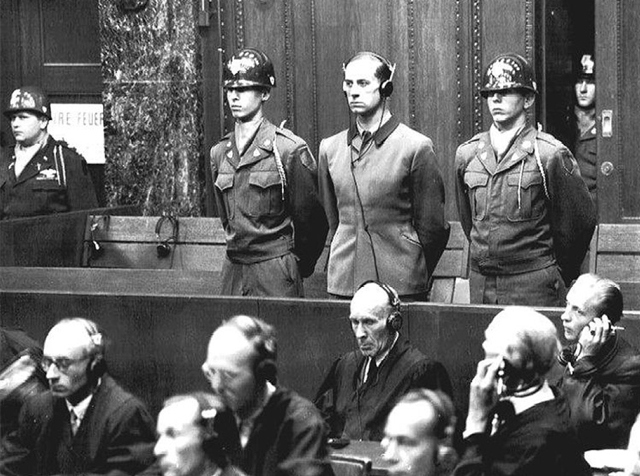
The military tribunal at Nuremberg, involving an international body of justice, sought to persecute the crimes of war committed during WWII.
By augmenting the current investigation proceedings, Stimson’s approach again illustrates the power of the government bureaucracy. It also shows that the bureaucracy is susceptible to change. Stimson proves that although changing bureaucratic standard procedures is uncommon, it is possible for the realization of a larger goal.
For example, directive J.C.S. 1023/10, issued on July 8, 1945, detailed the military’s responsibilities for the Nuremberg Trials. This directive outlined the procedures for capturing war criminals and collecting evidence. 32 This directive illustrates the importance of the internal military bureaucracy as a tool for achieving international justice. The internal directive indicates that the military has significant influence in its own bureaucratic proceedings and that it is crucial for any implementation of policy, realist or idealist.
Although the Nuremberg Court is often viewed as purely idealistic, it contains aspects of realism when considering the alternative of a permanent UN war crimes court and failure of past precedents. Stimson’s plan did not originate purely from unifying themes of justice and fairness, but rather from desire for culpability, ensuring that Germany could not claim duress, and avoiding the UN war crimes court. In addition, his movement away from the precedent set by the Leipzig courts illustrates that standard military procedure is malleable when faced with a directive from the Joint Chiefs of Staff. By implementing a successful fact finding operation using the military, Stimson proved the relevance of bureaucratic procedures and the benefits acquired by using them.
Using the Nuremberg Trials for a case study in the interactions between realism and idealism combined with standard operating procedures yields important insights. It shows that standard operating procedures are not merely tools of realists but rather can be used in pursuit of idealist claims when a higher authority gives clear directives. In addition, it demonstrates that the interaction between realism and idealism is more complex than lofty rhetoric suggested. Both Morgenthau and Stimson wanted to hold the German officers accountable. However, Stimson represented a mostly idealist perspective and successfully manipulated military standard operating procedures to create the Nuremberg Courts: the foundation of modern war crimes justice.
- The Government of the United States of America, The Provisional Government of the French Republic, The Government of the United Kingdom of Great Britain and Northern Ireland, and The Government of the Union of Soviet Socialist Republics, “Charter of the International Military Tribunal” (London, United Kingdom, August 8, 1945), Sec. II, accessed March 7, 2013, http://avalon. law.yale.edu/imt/imtconst.asp#sec2.
- Please see John Locke, Second Treatise of Government (n.p., 1690), accessed March 22, 2014, http://www.gutenberg.org/files/7370/7370-h/7370-h.htm.
- Walter Russell Mead, Special Providence (New York, NY: Taylor & Francis Books, 2002; New York, NY: Routledge, 2009), xvii.
- Please note that Mead prefers to view foreign affairs political theory in terms of four schools of thought rather than realism versus idealism. However, his definition of the Wilsonian viewpoint is useful for defining idealism in this context.
- Hobbes famously describes life as “nasty, brutish, and short,” stating that man needs the state (the Leviathan) to govern his passions and establish order. Please see Thomas Hobbes, Leviathan (n.p., 1651), accessed March 22, 2014, http://www.gutenberg.org/files/3207/3207-h/3207-h.htm.
- Joseph S. Nye, Jr. and David A. Welch, Understanding Global Conflict and Cooperation, 9th ed. (Boston, MA: Pearson, 2009), 5.
- Graham Allison and Philip Zelikow, Essence of Decision: Explaining the Cuban Missile Crisis, 2nd ed. (New York, NY: Longman, 1999), 143.
- The Governments of the United States of America, Great Britain, the Soviet Union, and China. “Joint Four-Nation Declaration” (Moscow Conference, Moscow, Soviet Union, October 1943), accessed March 2, 2013, http://avalon.law.yale.edu/wwii/moscow.asp.
- Joseph Brunner, “American Involvement in the Nuremberg War Crimes Trial Process,” University of Michigan Journal of History, Winter 2002, 3, accessed March 2, 2013, http://www.umich. edu/~historyj/pages_folder/articles/American_Involvement_in_the_Nuremberg_War_Crimes_Trial_ Process.pdf.
- Bradley F. Smith, The Road to Nuremberg (New York, NY: Basic Books, 1981), 37.
- Laurie A. Cohen, “Application of the Realist and Liberal Perspectives to the Implementation of War Crimes Trials: Case Studies of Nuremberg and Bosnia,” UCLA Journal of International Law and Foreign Affairs 2, no. 113 (Spring/Summer 1997): 33, accessed March 7, 2013, https:// litigation-essentials.lexisnexis.com/webcd/app?action=DocumentDisplay&crawlid=1&doctype= cite&docid=2+UCLA+J.+Int’l+L.+%26+For.+Aff.+113&srctype=smi&srcid= 3B15&key=c748ef8d385e98a94df04d05c9bd9ac8.
- Cordell Hull and Henry Stimson to Franklin D. Roosevelt, memorandum, “Trial and Punishment of European War Criminals,” November 27, 1944, The War Crimes Trials at Nuremberg, Harry S. Truman Library and Museum, Independence, MO, accessed March 2, 2013, http://www. trumanlibrary.org/whistlestop/study_collections/nuremberg/documents/index.php?documentdate= 1944-11-27&documentid=8-7&studycollectionid=&pagenumber=1.
- Memorandum by Cordell Hull, Henry Stimson, and James Forrestal, “Nazi Atrocities, Both Pre-War and Since, Committed Pursuant to Criminal Conspiracy and Punishable as Such,” November 1944, The War Crimes Trials at Nuremberg, Henry S. Truman Library and Museum, Independence, MO, accessed March 2, 2013, http://www.trumanlibrary.org/whistlestop/study_ collections/nuremberg/documents/index.php?pagenumber=5&documentid=8-11&documentdate=1944-11-00&studycollectionid=nuremberg&groupid=.
- Henry Stimson, “The Nuremberg Trial: Landmark in Law,” Foreign Affairs 25, no. 2 (January 1947): 179-180 accessed March 2, 2013, http://www.jstor.org/stable/20030031?seq=6.
- Ibid, 189.
- Hull and Stimson to Roosevelt, memorandum, “Trial and Punishment of European War Criminals.”
- The Treaty of Versailles was signed on June 28, 1919 and ended World War I. The treaty placed stringent requirements on Germany including demilitarization of the Rhineland and payment of hefty reparations for the war. The Treaty of Versailles is often sited as a potential cause of World War II. Please see United States Holocaust Memorial Museum, “Treaty of Versailles, 1919,” in Holocaust Encyclopedia (n.p.: n.p., 2013), accessed March 22, 2014, http://www.ushmm.org/wlc/ en/article.php?ModuleId=10005425.
- Adolf Hitler, Mein Kampf, trans. James Murphy (n.p.: Hurst and Blackett, 1939, 321 accessed March 7, 2013, http://gutenberg.net.au/ebooks02/0200601.txt.
- Smith, The Road to Nuremberg, 38.
- Ibid, 40.
- Hull and Stimson to Roosevelt, memorandum, “Trial and Punishment of European War Criminals.”
- Brunner, “American Involvement in the Nuremberg,” 3.
- United Nations War Crimes Commission, Draft Convention for the Establishment of a United Nations War Crimes Court, September 30, 1944, The War Crimes Trials at Nuremberg, Harry S. Truman Library and Museum, Independence, MO, accessed March 7, 2013, http://www.trumanlibrary. org/whistlestop/study_collections/nuremberg/documents/index.php?pagenumber=1&documentdate= 1944-09-30&documentid=8-1&studycollectionid=nuremberg.
- Memorandum by British Embassy, “United Nations War Crimes Court,” October 30, 1944, The War Crimes Trials at Nuremberg, Harry S. Truman Library and Museum, Independence, MO, accessed March 2, 2013, http://www.trumanlibrary.org/whistlestop/study_collections/nuremberg/ documents/index.php?pagenumber=1&documentdate=1944-10-30&documentid=8-2&studycollectionid= nuremberg.
- Memorandum by Hull, Stimson, and Forrestal, “ Nazi Atrocities, Both Pre-War and Since.”
- Jürgen Matthäus, The Lessons of Leipzig, in Atrocities on Trial, ed. Jürgen Matthäus and Patricia Heberer (Lincoln, NE: University of Nebraska, 2008), 9.
- Kerstin von Lingen, Kesselring’s Last Battle, trans. Alexander Klemm (Lawrence, KS: University Press of Kansas, 2009), 70.
- United States Holocaust Memorial Museum, “International Military Tribunal at Nuremberg,” Holocaust Encyclopedia, last modified May 11, 2012, accessed March 2, 2013, http://www.ushmm. org/wlc/en/article.php?ModuleId=10007069.
- Telford Taylor, Final Report to the Secretary of the Army on the Nuernberg War Crimes Trials under Control Council Law No. 10 (Washington, DC, 1949; repr., Buffalo, NY: William S. Hein & Co., 1997), 2.
- Ibid.
- Michael Salter, Nazi War Crimes, US Intelligence and Selective Prosecution at Nuremberg (New York, NY: Routledge-Cavendish, 2007), 2.
- Taylor, Final Report to the Secretary, 242.
Endnotes
- The Government of the United States of America, The Provisional Government of the French Republic, The Government of the United Kingdom of Great Britain and Northern Ireland, and The Government of the Union of Soviet Socialist Republics, “Charter of the International Military Tribunal” (London, United Kingdom, August 8, 1945), Sec. II, accessed March 7, 2013, http://avalon. law.yale.edu/imt/imtconst.asp#sec2.
- Please see John Locke, Second Treatise of Government (n.p., 1690), accessed March 22, 2014, http://www.gutenberg.org/files/7370/7370-h/7370-h.htm.
- Walter Russell Mead, Special Providence (New York, NY: Taylor & Francis Books, 2002; New York, NY: Routledge, 2009), xvii.
- Please note that Mead prefers to view foreign affairs political theory in terms of four schools of thought rather than realism versus idealism. However, his definition of the Wilsonian viewpoint is useful for defining idealism in this context.
- Hobbes famously describes life as “nasty, brutish, and short,” stating that man needs the state (the Leviathan) to govern his passions and establish order. Please see Thomas Hobbes, Leviathan (n.p., 1651), accessed March 22, 2014, http://www.gutenberg.org/files/3207/3207-h/3207-h.htm.
- Joseph S. Nye, Jr. and David A. Welch, Understanding Global Conflict and Cooperation, 9th ed. (Boston, MA: Pearson, 2009), 5.
- Graham Allison and Philip Zelikow, Essence of Decision: Explaining the Cuban Missile Crisis, 2nd ed. (New York, NY: Longman, 1999), 143.
- The Governments of the United States of America, Great Britain, the Soviet Union, and China. “Joint Four-Nation Declaration” (Moscow Conference, Moscow, Soviet Union, October 1943), accessed March 2, 2013, http://avalon.law.yale.edu/wwii/moscow.asp.
- Joseph Brunner, “American Involvement in the Nuremberg War Crimes Trial Process,” University of Michigan Journal of History, Winter 2002, 3, accessed March 2, 2013, http://www.umich. edu/~historyj/pages_folder/articles/American_Involvement_in_the_Nuremberg_War_Crimes_Trial_ Process.pdf.
- Bradley F. Smith, The Road to Nuremberg (New York, NY: Basic Books, 1981), 37.
- Laurie A. Cohen, “Application of the Realist and Liberal Perspectives to the Implementation of War Crimes Trials: Case Studies of Nuremberg and Bosnia,” UCLA Journal of International Law and Foreign Affairs 2, no. 113 (Spring/Summer 1997): 33, accessed March 7, 2013, https:// litigation-essentials.lexisnexis.com/webcd/app?action=DocumentDisplay&crawlid=1&doctype= cite&docid=2+UCLA+J.+Int’l+L.+%26+For.+Aff.+113&srctype=smi&srcid= 3B15&key=c748ef8d385e98a94df04d05c9bd9ac8.
- Cordell Hull and Henry Stimson to Franklin D. Roosevelt, memorandum, “Trial and Punishment of European War Criminals,” November 27, 1944, The War Crimes Trials at Nuremberg, Harry S. Truman Library and Museum, Independence, MO, accessed March 2, 2013, http://www. trumanlibrary.org/whistlestop/study_collections/nuremberg/documents/index.php?documentdate= 1944-11-27&documentid=8-7&studycollectionid=&pagenumber=1.
- Memorandum by Cordell Hull, Henry Stimson, and James Forrestal, “Nazi Atrocities, Both Pre-War and Since, Committed Pursuant to Criminal Conspiracy and Punishable as Such,” November 1944, The War Crimes Trials at Nuremberg, Henry S. Truman Library and Museum, Independence, MO, accessed March 2, 2013, http://www.trumanlibrary.org/whistlestop/study_ collections/nuremberg/documents/index.php?pagenumber=5&documentid=8-11&documentdate=1944-11-00&studycollectionid=nuremberg&groupid=.
- Henry Stimson, “The Nuremberg Trial: Landmark in Law,” Foreign Affairs 25, no. 2 (January 1947): 179-180 accessed March 2, 2013, http://www.jstor.org/stable/20030031?seq=6.
- Ibid, 189.
- Hull and Stimson to Roosevelt, memorandum, “Trial and Punishment of European War Criminals.”
- The Treaty of Versailles was signed on June 28, 1919 and ended World War I. The treaty placed stringent requirements on Germany including demilitarization of the Rhineland and payment of hefty reparations for the war. The Treaty of Versailles is often sited as a potential cause of World War II. Please see United States Holocaust Memorial Museum, “Treaty of Versailles, 1919,” in Holocaust Encyclopedia (n.p.: n.p., 2013), accessed March 22, 2014, http://www.ushmm.org/wlc/ en/article.php?ModuleId=10005425.
- Adolf Hitler, Mein Kampf, trans. James Murphy (n.p.: Hurst and Blackett, 1939, 321 accessed March 7, 2013, http://gutenberg.net.au/ebooks02/0200601.txt.
- Smith, The Road to Nuremberg, 38.
- Ibid, 40.
- Hull and Stimson to Roosevelt, memorandum, “Trial and Punishment of European War Criminals.”
- Brunner, “American Involvement in the Nuremberg,” 3.
- United Nations War Crimes Commission, Draft Convention for the Establishment of a United Nations War Crimes Court, September 30, 1944, The War Crimes Trials at Nuremberg, Harry S. Truman Library and Museum, Independence, MO, accessed March 7, 2013, http://www.trumanlibrary. org/whistlestop/study_collections/nuremberg/documents/index.php?pagenumber=1&documentdate= 1944-09-30&documentid=8-1&studycollectionid=nuremberg.
- Memorandum by British Embassy, “United Nations War Crimes Court,” October 30, 1944, The War Crimes Trials at Nuremberg, Harry S. Truman Library and Museum, Independence, MO, accessed March 2, 2013, http://www.trumanlibrary.org/whistlestop/study_collections/nuremberg/ documents/index.php?pagenumber=1&documentdate=1944-10-30&documentid=8-2&studycollectionid= nuremberg.
- Memorandum by Hull, Stimson, and Forrestal, “ Nazi Atrocities, Both Pre-War and Since.”
- Jürgen Matthäus, The Lessons of Leipzig, in Atrocities on Trial, ed. Jürgen Matthäus and Patricia Heberer (Lincoln, NE: University of Nebraska, 2008), 9.
- Kerstin von Lingen, Kesselring’s Last Battle, trans. Alexander Klemm (Lawrence, KS: University Press of Kansas, 2009), 70.
- United States Holocaust Memorial Museum, “International Military Tribunal at Nuremberg,” Holocaust Encyclopedia, last modified May 11, 2012, accessed March 2, 2013, http://www.ushmm. org/wlc/en/article.php?ModuleId=10007069.
- Telford Taylor, Final Report to the Secretary of the Army on the Nuernberg War Crimes Trials under Control Council Law No. 10 (Washington, DC, 1949; repr., Buffalo, NY: William S. Hein & Co., 1997), 2.
- Ibid.
- Michael Salter, Nazi War Crimes, US Intelligence and Selective Prosecution at Nuremberg (New York, NY: Routledge-Cavendish, 2007), 2.
- Taylor, Final Report to the Secretary, 242.
Suggested Reading from Inquiries Journal
On November 21, 1945, Robert H. Jackson, the Chief Prosecutor for the United States of America opened the prosecution’s case against German defendants in Nuremberg, Germany. The war in Europe had ended only six months earlier, many of the buildings in Nuremberg and the rest of Germany still bearing the physical scars of bombing... MORE»
The North American Treaty Organization (NATO) was founded at the outset of the Cold War and served as a collective defense alliance of states in North America and Western Europe against the Soviet bloc. However, following... MORE»
World War II ranks among the deadliest military conflicts in history. From 1939-1945, the estimated number of casualties worldwide exceeded 60 million.[1] The United States suffered military fatalities in excess of four... MORE»
It is often thought that great military strategists do not engage in simple, frontal assaults, but instead devise complex plans meant to deceive, manipulate, and surprise their enemies. However, do such strategies always... MORE»
Latest in International Affairs
2022, Vol. 14 No. 04
With over 10 million stateless people globally, statelessness has increasingly become a pressing issue in international law. The production of statelessness occurs across multiple lines including technical loopholes, state succession, and discriminatory... Read Article »
2021, Vol. 13 No. 09
The COVID-19 crisis has exacerbated current global challenges. However, this article argues that this time of crisis can also be a unique opportunity for the existing global economic institutions - G20, WTO, IMF, and World Bank (WB) - to make the... Read Article »
2021, Vol. 13 No. 02
On January 1st, 1959, a small band of Cuban rebels shocked the world, overthrowing the American-backed dictator Fulgencio Batista. These rebels were especially known for their guerrilla tactics and their leaders, such as Fidel Castro and Ernesto... Read Article »
2021, Vol. 13 No. 01
Israel has increased the nation’s security presence around the Gaza Strip and in the West Bank. Here, the research project analyzes how transaction costs resulting from Israeli security policy impact the output of manufacturing activities... Read Article »
2020, Vol. 12 No. 09
The necessity of international relief is unending as new crises continue to emerge across the world. International aid plays a crucial role in shaping how affected communities rebuild after a crisis. However, humanitarian aid often results in a... Read Article »
2019, Vol. 11 No. 10
This article aims to present the biopiracy of traditional knowledge from India by the United States, which has occurred directly through the use of patent law and indirectly through economic power and cultural imperialism. Throughout this essay,... Read Article »
2018, Vol. 10 No. 10
After joining the European Union (EU) and the North Atlantic Treaty Organization (NATO) in 2004, Estonians felt secure and in charge of their future. However, following the 2007 Bronze Horseman incident in the Estonian capital of Tallinn which included... Read Article »
|











